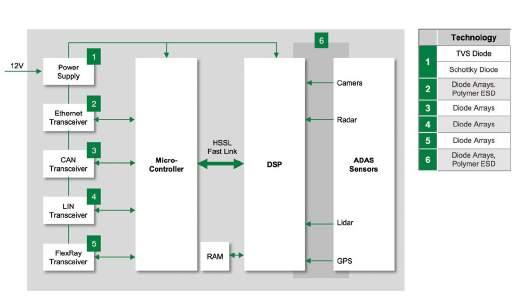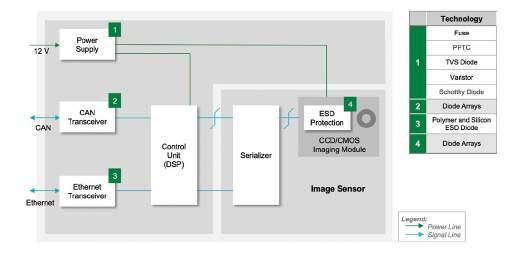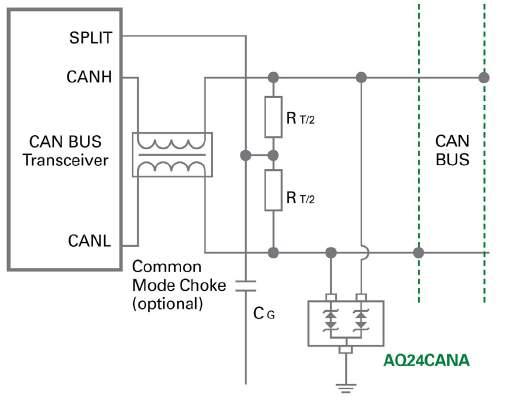
12 minute read
POWER
How to Protect Autonomous Vehicle Electronics Circuits Jim Colby
Marketing Engineer, Littelfuse, Inc. Widespread adoption of autonomous vehicles (AV) cannot be achieved unless the vehicle’s electronic circuits are robust to electrical shocks to ensure high reliability as well as driver and passenger safety. Electronics design engineers can significantly reduce the potential of circuit failures by incorporating electrostatic discharge (ESD) protection, overcurrent protection, transient surge protection, and reverse polarity protection. This article presents circuit protection recommendations for three mission-critical subsystems in their autonomous vehicles—camera, radar, and ADAS.
Advertisement
Figure 1. Advanced Autonomous Vehicle Sensing Systems
Recommended protection for ADAS subsystem
As the name implies, the advanced driver-assistance systems (ADAS) incorporate the communication, signal processing, and control subsystem that operate an autonomous vehicle. This main subsystem must be robust and reliable. These circuits must identify other vehicles in traffic, may need to make fast stops due to an animal or person obstructing the vehicle’s path, and needs to have a fail-safe response to a failed sensor. This article’s focus is on ensuring the hardware survives transient energy strikes. All circuitry that supplies information to the ADAS controller needs ESD protection. Figure 2 shows an example ADAS communication and control subsystem block diagram.

The power supply requires protection from overcurrents, surges, and reverse polarity. The ADAS power supply fuse can be located within the module, or further upstream in the vehicle’s low voltage junction box. A transient voltage suppressor (TVS) diode, selected for its surge power rating, provides the necessary surge transient protection. A Schottky diode in series with the power supply input line provides reverse voltage polarity protection.
Each LIN, CAN, and Ethernet communication links require ESD protection designed for the unique performance and configuration of each port. The communication protocols used in the ADAS communication and control subsystem and their different data rates are shown in Table 1. A wide range of TVS diode arrays and polymer ESD suppressors enable electronics engineers to incorporate robust protection without compromising its data rate or its high-to-low voltage differential.
Protocol
LIN CAN Automotive Ethernet
Bit Rate / Frequency
< 20 kbps < 1 Mbps to < 10 Mbps 100 Mbps, 1 Gbps
Table 1. Communication protocols used in vehicles
All signal lines connecting with the DSP circuit block require ESD protection. Use TVS diode arrays or polymer ESD suppressors with bipolar protection for the high and low signal lines. The primary intelligence for autonomous vehicles starts and ends with the ADAS subsystem. It is mission-critical to ensure that this subsystem remains operational at all times. Be sure to incorporate protection on all subsystem inputs and outputs from disabling ESD strikes and use TVS diodes to provide surge protection against transients generated by electric and electromechanical devices.
Recommended protection for camera subsystem
The cameras provide backward and forward vision that enable the system to “see” objects behind or in front of the vehicle for lane maintenance and collision avoidance. Multiple cameras provide depth perception and convert visual light using a CCD/CMOS image sensor into signals sent to the ADAS subsystem. Figure 3 illustrates a camera subsystem’s circuitry. The key circuits that need protection are the blocks connecting with external power and communications circuitry.
Power Supply

The camera power supply requires protection from three potential sources of damage: overcurrents, high energy transients, and ESD. Overcurrent protection is provided via a fuse. Select either a one-time blow ceramic fuse, or a polymer-based, positive temperature coefficient (PPTC) resettable fuse. The PPTC’s advantage is that it will not need replacement if an overcurrent condition occurs. In response to the heat generated by an overcurrent, the PPTC increases in resistance. Once the overcurrent is removed, the PPTC recovers to a low resistance, then it resets the circuit. Both components have surface mountable packages that save valuable PC board space.
In addition to overcurrents, power supply circuity requires protection from high energy transients that can be caused by in-vehicle sources (e.g., motors energizing and de-energizing). As defined by ISO Standards 7637 and 16750, the circuitry must be capable of withstanding significant transients. Compliant components include TVS diodes that can safely absorb both low-energy transients and high-energy transients as specified in Pulses 1, 2, 3 and 5 in the above referenced standards. If the voltage polarity to the power supply is accidentally reversed, designers can insert a Schottky diode in series with the fuse to avoid catastrophic failure. The diode’s low forward voltage drop will have a minimal impact on power supply performance while providing reverse polarity protection.
CAN Transceiver
The Controller Area Network (CAN) transceiver requires protection from ESD, fast electrical transients, and overvoltage transients. High ESD robustness is available with TVS diode arrays that have 30kV air and 30kV contact discharge capabilities. These devices help meet the ISO 10605 standard for ESD in vehicles. The recommended circuit for protecting a CAN transceiver is shown in Figure 4. Both the high and low lines are protected by a two-channel diode array, like the automotivequalified AQ24CANA. To help reduce pick-and-place costs in production, a single protection component is recommended.

Ethernet Transceiver
Provide the needed protection for the Ethernet transceiver’s high-speed differential data lines using either diode arrays or polymer ESD suppressors. Models of these diode arrays can provide up to ±30 kV ESD protection and can protect a differential line pair in a single package for space savings. An 0402 version is also available as a discrete component to allow for more PC board layout flexibility. When the capacitance must be the absolute lowest, a polymer ESD suppressor like the AXGD1 series with 0.04pF should be considered. With this low capacitance, it won’t impede 1 Gbit Ethernet transmission rates. See Figure 5 for an example circuit configuration that is consistent with recommendations from the OPEN Alliance Ethernet organization

Figure 5. Ethernet transceiver ESD protection
Image Sensor
The image sensor is the most important camera circuit. A bipolar, low-capacitance TVS diode, like the AQ3045 series, withstands an ESD strike up to ±30 kV, and has a low leakage current less than 10 nA, and has capacitance around 0.35 pF. For space efficiency, this diode is available in a very small, 1.0 mm x 0.5 mm SOD882 package.
Protecting the circuitry that interfaces with external circuits and environments help ensure a robust, reliable, visible light detection system. Using these recommended components, as close as possible to the circuit inputs, helps keep extraneous energy from damaging critical circuitry.
Recommended protection for radar subsystem
The radar system is crucial for the safe operation of an autonomous vehicle. It is, like the camera system, another set of eyes that monitor road conditions. Protection of its circuitry from external hazards is essential.
The radar subsystem (shown in Figure 6) provides the input for the forward-and-side pedestrian detection and collision avoidance functions. The circuit has two DC power supplies. The power supply that powers the analog radar transmitter and the radar receiver circuits is a low-noise supply. A conventional power supply handles the logic and communication circuits.
Power Supplies
The radar subsystem’s power supplies should have protection against four threats: overcurrent, transient surges, reverse polarity, and ESD.
One set of devices protect both supplies from overcurrents and reverse polarity. Again, the design engineer can select
Figure 6. Radar subsystem

from either a surface-mount fuse or a PPTC resettable fuse. To provide reverse polarity protection for the power supplies and for all the radar subsystem circuitry, use a low forward voltage Schottky diode in series with the input line to both supplies. Be sure to also provide the individual supplies with surge protection at the input to each supply.
Use TVS diodes for surge protection. Choose the part based on its transient power rating. To protect the power supplies, use 400W/600W for low-power transients and 1,500W to 7,000W for high-power transients.
Waveform Generator and Analog Frontend
The waveform generator and analog frontend are part of the radar transmitter and radar receiver, respectively. They are separated from the transmitter and receiver circuits in Figure 6 since the addition of protection components on the transmitter output and receiver input circuits would alter their transmission and reception impedance. The protection components safeguard as much of the circuits as possible. To provide the necessary ESD protection, use a bipolar TVS diode like the one recommended for the image sensor in the camera subsystem.
The radar subsystem, like the camera subsystem, transmits its information to the vehicle’s central processing subsystem. Bipolar TVS diode arrays provide ESD protection for both the high and low sides of CAN lines. The Ethernet transceiver can use either diode arrays or polymer ESD suppressors to minimize signal distortion without impacting the Ethernet transmission rate.
Conclusion
Design engineers have a broad range of passive devices that they can use to protect their electronic circuitry from potential stresses. Utilizing AEC-Q qualified circuit protection can accelerate compliance with standards certifications while giving the design team confidence that the devices will provide the necessary level of protection.
For additional information on automotive circuit protection, see the Automotive Electronics Applications Guide courtesy of Littelfuse.
Internet of Behaviors (IoB)—An Extension of IoT
- Aishwarya Saxena
With the ever-increasing popularity of the Internet of Things (IoT) going on during the last few years, the number of devices using the technology has grown at an alarming rate. Ranging from wearables like smart fitness bands that track your fitness 24/7 to remotely accessing the electrical devices in your homes, IoT has expanded its reach in people’s day-to-day activities. While this technology has made a great shift in the market with its ever-advancing applications, industries still face difficulties to satisfy their customer’s needs according to their personalized demands. So, what if it’s possible to get every customer’s personalized preference data based on their usage of data? This is where the term Internet of Behaviour (IoB) came into existence. Let’s explore this new term and how it will help in profiting industries with its data collection.
Understanding IoB
We can better understand the Internet of Behaviours (IoB) as an extension of the Internet of Things. So, what makes it different from IoT? love engaging with, especially insurance providers and banking, the opportunity to change their image. Utilizing IoT, they can provide data-driven value, thus getting more success rates in satisfying their customer’s needs.
Real-Life Applications of IoB
The way big companies like Google, Facebook or Amazon have started doing marketing research is becoming more and more comprehensive. These companies have designed their algorithms such that they can anticipate their customer's desires and behaviors to get them a personalized experience. And though the B2B sector is advancing faster than B2C in IoB, it’s only a matter of time before it becomes popular. Let’s start with an example of a software company BMC that has developed a health app for smartphones to track users’ diet, sleep patterns, heart rate and blood sugar levels. This app can send an alert in adverse situations in the user’s health and also suggest behavioral modifications towards a more positive outcome.
While IoT is a network of interconnected physical objects, gathering and exchanging information and data over the internet, IoB simply makes sense of this collected data of every customer and attaches it to specific human behaviors such as purchasing type or following a specific brand online, etc. Internet of Behaviours or IoB can be defined as a process by which user-controlled data, collected during customer’s usage of apps, is analyzed through a behavioral psychology perspective. And using those results, the company can then offer a similar type of end product according to the customer’s preference.
The IoB concept aims towards understanding collected data properly and applying that understanding to create and promote new products using human psychological behaviors.
Significance of IoB
IoB’s main aim is to capture, analyze and respond to all types of human behaviors in such a way as to allow tracking and interpreting people’s behaviors using advanced technological innovations and developments in machine learning algorithms. Thus, using this concept, customer’s behaviors are analyzed and incentives or disincentives are applied to influence them to perform towards the desired set of operational parameters. What makes IoB more valuable is that it is not only descriptive but is also proactive that is detecting which psychological variables are going to influence that will bring about a certain outcome.
IoB, not only influences consumer choice but is also redesigning the value chain. Though a majority of consumers do not feel secure at giving away their data for free, many are satisfied with doing so if it brings them an added value. And that’s what gives companies the upper hand we don’t Taking another example into account, Uber uses IoT data on drivers, passenger locations and preferences to reinvent customer’s experience.
Also, large companies, like Ford, have partnered with startups, like Argo AI, to design and develop autonomous cars soon that will vary their behavior in each city based on that city’s vehicle traffic, bicycles and scooters, etc.
Taking another innovative approach in this technology, software company GBKSOFT has been working on a project to implement the IoB concept. The project is based on helping golfers to improve their playing skills with the help of a mobile app and tracking of wearable devices, that will correct existing ball-striking techniques and helps in learning new techniques. As the player uses the handheld device connected to the mobile phone, each hit on the golf ball is recorded in the app and then analyzed so that player can see their mistakes and get visual recommendations on how to improve their swing and stroke techniques.
IoB’s Future Horizons
Though we talked at length about the wide applications of IoB, the technology is still in its developing stage and it will take time for companies to unlock the full potential of the Internet of Behaviours or IoB, and also for the users to accept it as a way to get better services and customized products. Also, the security of personalized data is still a big task for companies to handle and make their users secure.
Despite all these shortcomings, many companies have started investing in IoT technologies now and have developed strategies to win the tough competition for customers' loyalty with the power of data and psychology.









